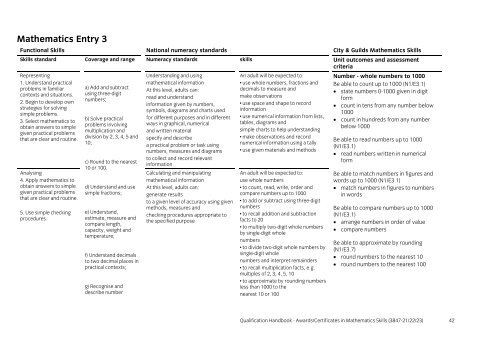Awards/certificates in mathematics skills (3847-21/22 ... - City & Guilds
Awards/certificates in mathematics skills (3847-21/22 ... - City & Guilds
Awards/certificates in mathematics skills (3847-21/22 ... - City & Guilds
You also want an ePaper? Increase the reach of your titles
YUMPU automatically turns print PDFs into web optimized ePapers that Google loves.
Mathematics Entry 3<br />
Functional Skills National numeracy standards <strong>City</strong> & <strong>Guilds</strong> Mathematics Skills<br />
Skills standard Coverage and range Numeracy standards <strong>skills</strong> Unit outcomes and assessment<br />
criteria<br />
Represent<strong>in</strong>g<br />
1. Understand practical<br />
problems <strong>in</strong> familiar<br />
contexts and situations.<br />
2. Beg<strong>in</strong> to develop own<br />
strategies for solv<strong>in</strong>g<br />
simple problems.<br />
3. Select <strong>mathematics</strong> to<br />
obta<strong>in</strong> answers to simple<br />
given practical problems<br />
that are clear and rout<strong>in</strong>e.<br />
Analys<strong>in</strong>g<br />
4. Apply <strong>mathematics</strong> to<br />
obta<strong>in</strong> answers to simple<br />
given practical problems<br />
that are clear and rout<strong>in</strong>e.<br />
5. Use simple check<strong>in</strong>g<br />
procedures.<br />
a) Add and subtract<br />
us<strong>in</strong>g three-digit<br />
numbers;<br />
b) Solve practical<br />
problems <strong>in</strong>volv<strong>in</strong>g<br />
multiplication and<br />
division by 2, 3, 4, 5 and<br />
10;<br />
c) Round to the nearest<br />
10 or 100.<br />
d) Understand and use<br />
simple fractions;<br />
e) Understand,<br />
estimate, measure and<br />
compare length,<br />
capacity, weight and<br />
temperature;<br />
f) Understand decimals<br />
to two decimal places <strong>in</strong><br />
practical contexts;<br />
g) Recognise and<br />
describe number<br />
Understand<strong>in</strong>g and us<strong>in</strong>g<br />
mathematical <strong>in</strong>formation<br />
At this level, adults can:<br />
read and understand<br />
<strong>in</strong>formation given by numbers,<br />
symbols, diagrams and charts used<br />
for different purposes and <strong>in</strong> different<br />
ways <strong>in</strong> graphical, numerical<br />
and written material<br />
specify and describe<br />
a practical problem or task us<strong>in</strong>g<br />
numbers, measures and diagrams<br />
to collect and record relevant<br />
<strong>in</strong>formation<br />
Calculat<strong>in</strong>g and manipulat<strong>in</strong>g<br />
mathematical <strong>in</strong>formation<br />
At this level, adults can:<br />
generate results<br />
to a given level of accuracy us<strong>in</strong>g given<br />
methods, measures and<br />
check<strong>in</strong>g procedures appropriate to<br />
the specified purpose<br />
An adult will be expected to:<br />
• use whole numbers, fractions and<br />
decimals to measure and<br />
make observations<br />
• use space and shape to record<br />
<strong>in</strong>formation<br />
• use numerical <strong>in</strong>formation from lists,<br />
tables, diagrams and<br />
simple charts to help understand<strong>in</strong>g<br />
• make observations and record<br />
numerical <strong>in</strong>formation us<strong>in</strong>g a tally<br />
• use given materials and methods<br />
An adult will be expected to:<br />
use whole numbers<br />
• to count, read, write, order and<br />
compare numbers up to 1000<br />
• to add or subtract us<strong>in</strong>g three-digit<br />
numbers<br />
• to recall addition and subtraction<br />
facts to 20<br />
• to multiply two-digit whole numbers<br />
by s<strong>in</strong>gle-digit whole<br />
numbers<br />
• to divide two-digit whole numbers by<br />
s<strong>in</strong>gle-digit whole<br />
numbers and <strong>in</strong>terpret rema<strong>in</strong>ders<br />
• to recall multiplication facts, e.g.<br />
multiples of 2, 3, 4, 5, 10<br />
• to approximate by round<strong>in</strong>g numbers<br />
less than 1000 to the<br />
nearest 10 or 100<br />
Number - whole numbers to 1000<br />
Be able to count up to 1000 (N1/E3.1)<br />
• state numbers 0-1000 given <strong>in</strong> digit<br />
form<br />
• count <strong>in</strong> tens from any number below<br />
1000<br />
• count <strong>in</strong> hundreds from any number<br />
below 1000<br />
Be able to read numbers up to 1000<br />
(N1/E3.1)<br />
• read numbers written <strong>in</strong> numerical<br />
form<br />
Be able to match numbers <strong>in</strong> figures and<br />
words up to 1000 (N1/E3.1)<br />
• match numbers <strong>in</strong> figures to numbers<br />
<strong>in</strong> words<br />
Be able to compare numbers up to 1000<br />
(N1/E3.1)<br />
• arrange numbers <strong>in</strong> order of value<br />
• compare numbers<br />
Be able to approximate by round<strong>in</strong>g<br />
(N1/E3.7)<br />
• round numbers to the nearest 10<br />
• round numbers to the nearest 100<br />
Qualification Handbook - <strong>Awards</strong>/Certificates <strong>in</strong> Mathematics Skills (<strong>3847</strong>-<strong>21</strong>/<strong>22</strong>/23) 42
















